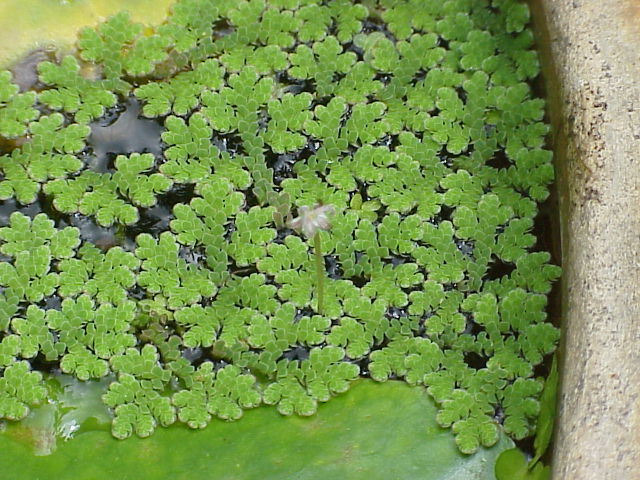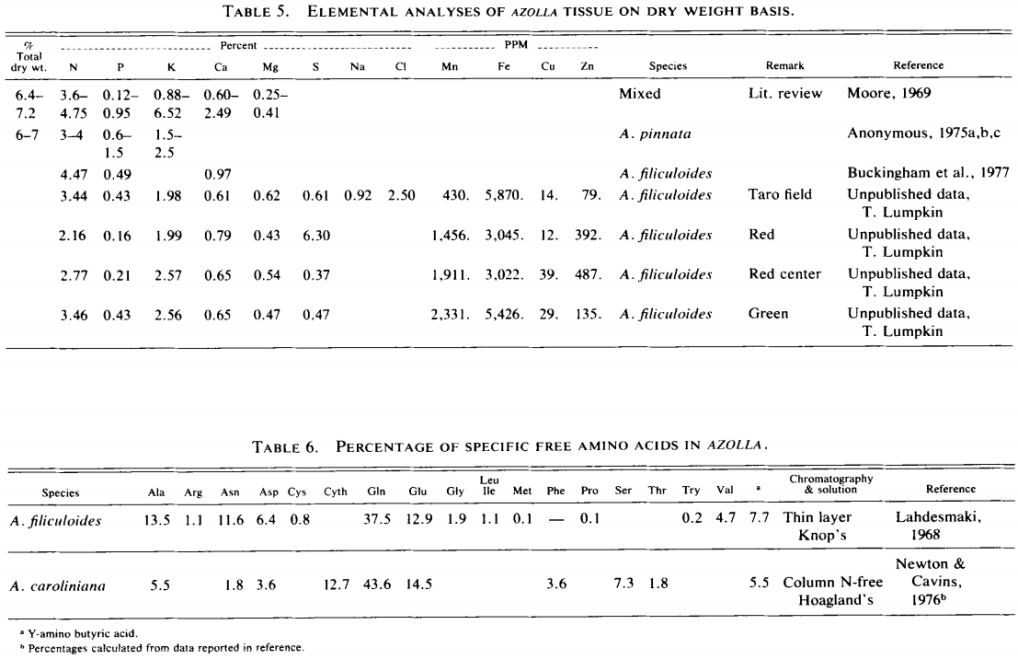 [1]
[1]
Azolla caroliniana
 [2]
[2]
Azolla caroliniana
 [3]
[3]
Azolla filiculoides
|
|
Practical ecological knowledge for the temperate reader. |
 [1] [1]
Azolla caroliniana |
 [2] [2]
Azolla caroliniana |
 [3] [3]
Azolla filiculoides |
Family: Azollaceae (Azolla family) [E-flora]
"General: Delicate aquatic fern floating on water surface, plants usually 0.5-1 cm long, dichotomously branched almost throughout; fronds rather widely spaced." [IFBC-E-flora]
"Habitat / Range Surface of water, garden ponds, sloughs and ditches in the lowland zone; locally frequent in SW BC; introduced from E North America." [IFBC-E-flora]
Status: Exotic [E-flora]
References
"(Greek: dry kill, from plant death in dried habitats) [Reid et al. 2006 Int J Plant Sci 167:529–538] Used as green manure in rice paddies because of nitrogen-fixing algae in upper leaf lobe; species identification difficult, depends in part on fertile material (generally 0 on herbarium specimens). Species hybridize in culture.
Unabridged references: [Perkins et al. 1985 Scanning Electron Microscopy 1985(IV):1719–1734; Evard & Van Hove 2004 Syst. Geogr. Plant. 74:301–318]
Unabridged note: Evard & Van Hove (2004) treated Azolla microphylla as a synonym of Azolla filiculoides, suggesting that plants here called Azolla microphylla might instead belong to Azolla cristata Kaulf., although no California material was referred to this sp. by them." [Jepson]
Local Species;
Species & Distribution
"Azolla occurs in ponds, ditches and paddy fields of warm-temperate and tropical regions throughout the world (Fig. 4). Prior to their dispersal by man, the species were endemic to the following areas:" [Azolla]
"According to Sculthorpe (1967), A. filiculoides was formerly native to Europe, but probably died out during the last Ice Ages. In the 19th century, it was reintroduced into western Europe, along with A. caroliniana and A. pinnata, as an ornamental (Saccardo, 1892; Marsh, 1914; Chevalier, 1926; Sculthorpe, 1967), and it spread unchecked until it became a nuisance (Bolos and Masclans, 1955; Sculthorpe, 1967). This sequence of events was repeated in South Africa, New Zealand and elsewhere (Matthews, 1963; Fosberg, 1942; Oosthuizen and Walters, 1961; Ashton and Walmsley, 1976)." [Azolla]
"General: Delicate aquatic ferns floating on water surface; plants usually 2-6 cm long, pinnately branched from a central axis, dichotomously branched only at the periphery; fronds usually densely overlapping like shingles." [IFBC-E-flora]
"Habitat / Range Sloughs and ditches in the lowland zone; rare in SW BC, known from the lower Fraser River Valley; most probably introduced from E North America." [IFBC-E-flora]
Status: Native [E-flora]
Cultivation "Requires a sunny or lightly shaded position in still or slowly flowing water. Plants are not very cold tolerant, surviving overwintering in colder winter areas by means of submerged resting buds[200]. Plants seldom reproduce by spores[200]. This species has a symbiotic relationship with an algae which fixes atmospheric nitrogen[200]." [PFAF]
References
Image References
"The symbiosis of the water fern Azolla with the cyanobacterium Nostoc supplies rice fields with nitrogen." [Heldt PB]
"The plant is exceedingly good source of nitrogen-rich biomass that can be used as a fertilizer or can be added to the compost heap[200, 270]. Dynamic accumulator." [PFAF]
"Azolla pinnata (Bhakuni et al., 1969) - found to be antibiotically inactive by some previous workers yielded positive results under our conditions." [AAP Banerjee]
"Water fern (Azolla rubra) is common on the surface of ponds and other still bodies of water. It has been used overseas as food for animals, as a fertilizer in rice fields, as a utilizer of minerals, and as a source of oxygen in wastewater treatment ditches and ponds. A blue-green alga (Anabaena) living in the leaf of Azolla fixes atmospheric nitrogen and ultimatelymakes it available to surrounding plants; thus Azolla is valued as a fertilizer. The algal/fern symbiosis can also be used to produce hydrogen; it has been predicted that the process could be a valuable source of energy in times of high oil prices (Little 1979)." [ENPNZ Brooker]
| Azolla imbricata (Roxb.) Nakai - Man Jiang Hong [CRNAH] | |
| Major Constituents and (sources) (whole plant) Luteolinidin 5-glucoside, aesculetin, caffeic acid.57 | Therapeutic Values Treat cough, arthritis, eczema, swelling, diuretic. |

Nitrogen Fixation
"The most remarkable characteristic of Azolla is its symbiotic relationship with the nitrogen-fixing blue-green alga (cyanobacterium), Anabaena azollae. The delicate Azolla (Fig. 1) provides nutrients and a protective cavity in each leaf (Fig. 2) to Anabaena colonies in exchange for fixed atmospheric nitrogen and possibly other growth-promoting substances (Schaede, 1947; Ashton and Walmsley, 1976). The rate of nitrogen fixation in the Azolla-Anabaena symbiosis rivals that of the Rhizobium-legume symbiosis. Talley et al. (1977) reported a daily fixation rate of 1.2 kg N/ha and Dao and Tran (1966) reported an annual nitrogen yield of 864 kg N/ha." [Azolla]
Green Manure
"Azolla is primarily grown as a green manure for rice, but it is also grown with water bamboo (Zizanica aquatica), arrowhead (Sagittaria sagittifolia) and taro (Colocasia esculenta) (Anonymous, 1975b). The Kiangsu People's Publishers (Anonymous, 1976b) recently released a booklet about producing compost for use on any crop from Azolla, water hyacinth, and other aquatic weeds.
Ngo (1973) examined the positive effect of Azolla green manure on the number of shoots, length of longest leaf, fresh weight, and dry weight of rice plants. Shen et al. (1963) compared the nitrogen fixation ability of "Red Azolla" with alfalfa (Medicago sativa) and soybean (Glycine max). They discovered that 1.5 mo of Azolla cultivation increased the nitrogen content of the soil to a level equal to that produced by a crop of soybeans, but to only 40% of the level produced by alfalfa. Their calculations were based on alfalfa, soybean and "Red Azolla" nitrogen contents 2.87%, 2.90% and 3.5%, respectively (dry weight basis). Also, they pointed out that since cultivation of Azolla is combined with rice, it does not occupy extra land. Taller et al. (1977) reported that A. filiculoides could provide one half of the nitrogen requirement for California rice if it were grown as a green manure before rice seeding. Tran and Dao (1973) reported that two successive Azolla layers, incorporated into the soil before rice transplanting, can supply 50 percent of the nitrogen necessary to produce 5 tons of rice per hectare.
/ha in 30 days (Lu et al., 1963). The Institute of Soils and Fertilizers in the Chekiang Agriculture Academy, China (Anonymous, 1975b), reported that Azolla used as a green manure decreased specific gravity, increased porosity (3.7-4.2%) and increased organic matter in soils. Also, in one of their experiments, growth of Azolla reduced evaporation by 11%, water salt content by 0.012-0.049%, and soil salt content by 0.014-0.048%." [Azolla]
Composition
"On a dry weight basis (Tables 5, 6), Azolla has a substantial protein content, with reports as high as 13% (Tran and Dao, 1973), 16.1% (Anonymous, 1975a), 22.6% (Fujiwara et al., 1947) and 23.4% (Buckingham et al., 1977). Buckingham et al. (1977) conducted amino acid analyses and rat feeding experiments with A. filiculoides. Amino acid analysis indicated lysine, methionine and histamine were probably limiting. Feeding trials with Azolla verified the preceding point and indicated that indigestible fiber and minerals were excessive. Their experiments also indicated that Azolla did not contain growth inhibitors or toxins for rats.
On a dry weight basis, other reported constituents are: iignin 9.3% and cellulose 15.2% in A. filiculoides (Buckingham et al., 1977); ash 23.8%, fat 4.42%, fiber 9.5%, and starch 6.38% in A. pinnata (Fujiwara et al., 1947) and, also in A. pinnata, ash 9.7%, carbohydrate 61%, crude fat 6.3%, and protein 23% (Varghese et al., 1976)." [Azolla]
Mosquito control
"Around the turn of the century, a strong international interest developed in the use of Azolla (often called mosquito-fern) for mosquito control. Azolla mats were thought to prevent mosquitoes from laying eggs and prevent larvae from coming up for air (Benedict, 1923; King et al., 1942; Cohn and Renlund, 1953; Shaver, 1954; Neai, 1965; Burkill, 1966), but little hard evidence is available to support this claim.
A 1909 report by the U.S. Department of Commerce and Labor (cited by Howard, 1910) described research at a malaria station in Wilhelmshaven, Germany. Azolla was found to suffocate mosquito larvae and prevented the insect from depositing eggs; subsequently, it was used successfully by a mosquito-destroying commission on the Rhine. However, a German official involved with mosquito extermination in the African colonies of Germany was far from enthusiastic about its use. He believed Azolla could only be used in special places since the plant would not grow under the dense or even moderate shade of tropical forests, would not grow in brackish water or along seacoasts, and would die from drought and thus necessitate restocking." [Azolla]
"Misceilany.--Azolla has been found to help purify water (Cohn and Renlund, 1953); to be an ingredient in soap production by some African tribes (Chevalier, 1926) and was chewed to cure sore throat in New Zealand (Usher, 1974). Bui (1966) implied that with suitable processing Azolla could become a good source of human food. Dr. P. K. Singh (pers. comm.) wrote from Cuttack, India, that he has eaten Azolla regularly in several fried preparations; he reports that these preparations are tasty and do not cause digestive difficulties. He was taking steps to popularize the cultivation of Azolla in small trays for human consumption." [Azolla]
References